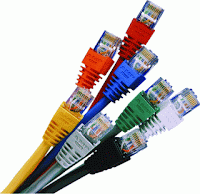Saturday, November 28, 2015
Standard UTP Cable
Often we are faced with problems that may seem trivialbut can be fatal in the future. For some people (including me once) connect the UTP cablewith RJ45 connectorsis sufficient from the two ends are the same color would have no problem. However, in a complex network involving many peopleand certainly itcould make problemsand complications occurred. Because it'simportant to do the installation standards.
UTP cable is atransmission medium of the most widely used to createa local network(Local Area Network), but because the price is relatively cheap, easy to install and quite reliable.As the name implies means Unshielded Twisted Pair Twisted pair wiring/ twisted (twisted pair) unprotected (unshielded). This coilfunctions are as inductionand elimination ofleaks. Earlier there were also wired STP (Shielded Twisted Pair), for example the image can be seen below:
There are several types of categories of UTP cable is a show quality, the number density of coil pair, the higher category of the meeting of the windings and other parameters such as the following:
Category 1 UTP cable
Used for telephone communication (transmit low speed data), so it is not suitable for transmitting data.
Category 2 UTP cable
Capable of transmitting data at speeds up to 4 Mbps (Megabits per second)
Category 3 UTP cable
Used in 10BaseT network, capable of transmitting data at speeds up to 1Mbps. 10BaseT stands for 10 Mbps, Baseband, Twisted pair.
Category 4 UTP cable
Often used in token ring topology, capable of transmitting data at speeds up to 16 Mbps
Category 5 UTP cable
capable of transmitting data at speeds up to 100 Mbps,
Category 5e UTP cable
capable of transmitting data at speeds up to 1000 Mbps (1Gbps), the frequency signal which can pass up to 100 MHz.
Category 6 UTP cable
Capable of transmitting data at speeds up to 1000 Mbps (1Gbps), the frequency signal which can pass up to 200 MHz. Physically there is a separator which is made of plastic that serves to separate the four pairs in the cable.
Category 7 UTP cable gigabit Ethernet (1Gbps), the frequency of 400 MHz signal
For UTP cabling, there are two types of UTP cabling commonly used in computer networks, especially LANs, the Straight Through Cable and Cross Over Cable
For UTP cabling, there are two types of UTP cabling commonly used in computer networks, especially LANs, the Straight Through Cable and Cross Over Cable
straight cable
Straight cable is a cable that has a way of mounting the same between the tip of one with the other end. Straight cables are used to connect two different devices.
Straight cable is a standard sequence like this is in accordance with the standard T-568A / T-568B (the most widely used) or is sometimes also used according to standard T-568A / T-568B as follows:
Examples of the use of straight wires are as follows:
1. Connecting the computer to switch
2. Connect the computer with the LAN cable modem / DSL
3. Connect the router to the LAN to the cable modem / DSL
4. Connect switch to router
5. Connect the hub to the router
1. Connecting the computer to switch
2. Connect the computer with the LAN cable modem / DSL
3. Connect the router to the LAN to the cable modem / DSL
4. Connect switch to router
5. Connect the hub to the router
Cross-over cable
Crossover cable is a cable that has a different arrangement between the tip of the end of the two. Cross over cable used to connect two devices together. The picture below is a standard arrangement of cross-over cable.
Examples of the use of crossover cables are as follows:
1. Connect two pieces of the computer directly
2. Switch to connect 2pieces
3. Connecting 2 pieces of hub
4. Connect switch to hub
5. Connect the computer with the router
8 pieces of existing wires in UTP cable is (either in straight or crossover cable) only four pieces are used to send and receive data, there are wires on pins 1,2,3 and 6.
Creating a Straight cable and Cross Over
To create a wired network using UTP cable, there are some tools we need to prepare, that is UTP cable, RJ-45 Connector, crimping tools, and RJ-45 LAN Tester, examples like the following picture:
good luck
Labels:
Computer




